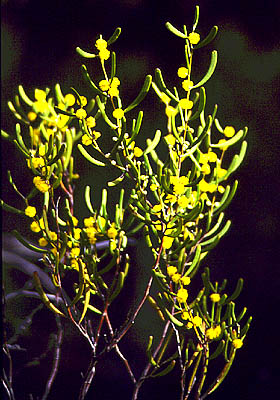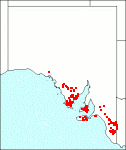Family: Fabaceae
Acacia farinosa

Citation:
J. Lindley in Mitch, Three Exped. E. Aust. 2:145 (1838).
Derivation: farinosus (Latin)--covered with mealiness or powdery, refers to the young stems and peduncles which are covered with a white mealiness. Synonymy: Acacia whanii F. Muell. ex Benth., Fl. Austral. 2:386 (1864). Common name: Mealy wattle
Description:
Small, much-branched, spreading shrubs 1-1.75 m high; branches terete or slightly angular, usually covered with a hoary white mealiness on young branchlets. Phyllodes linear to narrowly-obovate, 1.5-7cm long, 2-6 mm broad, usually gently curved, thick more or less fleshy when fresh, becoming wrinkled when dry; veins longitudinal, up to 7 on each face; blade broadest near the apex, obtuse and with a minute hard point, much narrowed towards the base; glands small on upper margin near base. Inflorescences simple and axillary, usually twin or sometimes in clusters up to four heads (rarely solitary); flower-heads small, globular, mid-yellow, 15-20-flowered; peduncles short, spreading, hoary; flowers 5-merous. Legumes linear, 3-6 cm long, 2-3 mm broad, curved or twisted, raised over the seeds, margins thickened, slightly constricted between seeds. Seeds longitudinal in legume, ellipsoid; funicle usually with 2-3 folds, thickened into a small aril.
|
|
Distribution:
|
In Eyre Peninsula, Yorke Peninsula (southern part), Kangaroo Island, Southern Lofty, Murray and South-Eastern regions. Associated mainly with Eucalyptus incrassata and Melaleuca uncinata in woodland to open scrub formation. Soils; occurs on a variety of soils but mainly sandy alkaline yellow duplex, red shallow porous loam or grey-brown calcareous loamy earths Rainfall 300-600 mm Also N.S.W. and Vic.
S.Aust.: EP, MU, YP, SL, KI, SE.
|
Conservation status:
Lang & Kraehenbuehl (1987) consider this species of no special conservation significance for the state but to be presumed extinct in the southern Mt Lofty Ranges and Rare in the Murray region. Flowering time: August — October. |

SA Distribution Map based
on current data relating to
specimens held in the
State Herbarium of South Australia
|
Biology:
No text
Related taxa:
Acacia sclerophylla has glabrous branches and peduncles, Acacia wilhelmiana is a viscid shrub with prominent golden pubescent peduncles, both lacking the hoary white mealiness of A. farinosa.
Cultivation:
A useful low spreading Acacia suitable for planting as a ground cover in coastal areas. Medium growth rate.
Author:
Not yet available
Source:

|

